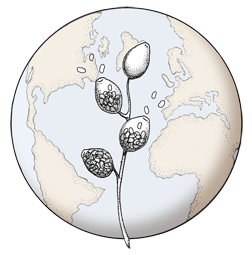References
Export 159 results:
Author Title Type [ Year ]
] Filters: First Letter Of Last Name is R [Clear All Filters]
. Cypress mortality (mal del ciprés) in the Patagonian Andes: comparisons with similar forest diseases and declines in North America. European Journal of Forest Pathology [Internet]. 1999 ;29:89–96. Available from: http://dx.doi.org/10.1046/j.1439-0329.1999.00133.x
. Diversity of Phytophthora megakarya in Central and West Africa revealed by isozyme and RAPD markers. Mycological Research [Internet]. 1999 ;103(10):1225 - 1234. Available from: http://www.sciencedirect.com/science/article/pii/S0953756208606711
. Phytophthora cinnamomi as a cause of oak mortality in the state of Colima, Mexico. Plant Disease [Internet]. 2000 ;84:394-398. Available from: http://apsjournals.apsnet.org/doi/abs/10.1094/PDIS.2000.84.4.394
. Occurrence of Phytophthora species in oak stands in Italy and their association with declining oak trees. Forest Pathology [Internet]. 2002 ;32:19–28. Available from: http://dx.doi.org/10.1046/j.1439-0329.2002.00264.x
. Pathogenicity of Phytophthora ramorum isolates from North America and Europe to bark of European Fagaceae, American Quercus rubra and other forest trees. In: Sudden oak death, a science symposium - the state of our knowledge, USDA Forest Service and University of California, Berkeley. Sudden oak death, a science symposium - the state of our knowledge, USDA Forest Service and University of California, Berkeley. ; 2002. pp. 30–31.
. Phytophthora ramorum as the cause of extensive mortality of Quercus spp. and Lithocarpus densiflorus in California. Plant Disease [Internet]. 2002 ;86:205-214. Available from: http://apsjournals.apsnet.org/doi/abs/10.1094/PDIS.2002.86.3.205
. Spread of an invasive pathogen over a variable landscape: a non-native root rot on Port Orford cedar. Ecology [Internet]. 2002 ;83:3167-3181. Available from: http://www.esajournals.org/doi/abs/10.1890/0012-9658%282002%29083%5B3167%3ASOAIPO%5D2.0.CO%3B2
. Non-oak native plants are main hosts for sudden oak death pathogen in California. Cal Ag [Internet]. 2003 ;57:18-23. Available from: http://ucanr.org/repository/cao/landingpage.cfm?article=ca.v057n01p18&abstract=yes
. Pathogenicity of Swedish isolates of Phytophthora quercina to Quercus robur in two different soils. New Phytologist. 2003 ;158(2):355 - 364.
. Phytophthora nemorosa, a new species causing cankers and leaf blight of forest trees in California and Oregon, U.S.A. Mycotaxon [Internet]. 2003 ;88:129–138. Available from: http://www.mycotaxon.com/vol/abstracts/88/88-129.html
. Phytophthora nemorosa, a new species causing cankers and leaf blight of forest trees in California and Oregon, U.S.A. Mycotaxon [Internet]. 2003 ;88:129–138. Available from: http://www.mycotaxon.com/vol/abstracts/88/88-129.html
. A range-wide assessment of Port-Orford-Cedar (Chamaecyparis lawsoniana) on federal lands. Portland, OR: U.S. Department of Agriculture, Forest Service, and U.S. Department of the Interior, Bureau of Land Management; 2003 p. 182. Available from: http://www.fs.fed.us/r6/dorena/publications/in/poc-range-wide-assessment
. Sudden oak death and associated diseases caused by Phytophthora ramorum. Plant Management Network - Plant Health Progress [Internet]. 2003 . Available from: http://www.plantmanagementnetwork.org/php/shared/sod/
. AFLP and phylogenetic analyses of North American and European populations of Phytophthora ramorum. Mycological Research [Internet]. 2004 ;108:378 - 392. Available from: http://www.sciencedirect.com/science/article/pii/S0953756208615609
. The decline of Austrocedrus chilensis forests in Patagonia, Argentina: soil features as predisposing factors. Forest Ecology and Management [Internet]. 2004 ;190:345 - 357. Available from: http://www.sciencedirect.com/science/article/B6T6X-4BD5PHG-4/2/6181ecf7a2cf4ba397d9afef97ee478d
. Detection and quantification of Phytophthora ramorum from California forests using a real-time polymerase chain reaction assay-0. Phytopathology [Internet]. 2004 ;94:1075-1083. Available from: http://apsjournals.apsnet.org/doi/abs/10.1094/PHYTO.2004.94.10.1075
. Occurrence and distribution of Phytophthora; species in European chestnut stands, and their association with Ink Disease and crown decline. European Journal of Plant Pathology [Internet]. 2005 ;111:169-180. Available from: http://dx.doi.org/10.1007/s10658-004-1882-0
. Phytophthora kernoviae sp. nov., an invasive pathogen causing bleeding stem lesions on forest trees and foliar necrosis of ornamentals in the UK. Mycological Research [Internet]. 2005 ;109:853 - 859. Available from: http://www.sciencedirect.com/science/article/B7XMR-4RS503Y-5/2/2264e8910ee36f4e72255d6160ebf9e4
. Phytophthora ramorum: integrative research and management of an emerging pathogen in California and Oregon forests. Annual Review of Phytopathology [Internet]. 2005 ;43:309. Available from: http://www.annualreviews.org/toc/phyto/43/1
. Phytophthora species from declining Austrocedrus chilensis forests in Patagonia, Argentina. Mycologia [Internet]. 2005 ;97:218-228. Available from: http://www.mycologia.org/cgi/content/abstract/97/1/218
. Relationships between health of Quercus robur, occurrence of Phytophthora species and site conditions in southern Sweden. Plant Pathology. 2005 ;54(4):502 - 511.
. Seasonal and spatial mortality patterns of holm oak seedlings in a reforested soil infected with Phytophthora cinnamomi. Forest Pathology [Internet]. 2005 ;35:411–422. Available from: http://dx.doi.org/10.1111/j.1439-0329.2005.00423.x
. Transmission of Phytophthora ramorum in mixed-evergreen forest in California. Phytopathology [Internet]. 2005 ;95:587-596. Available from: http://apsjournals.apsnet.org/doi/abs/10.1094/PHYTO-95-0587
. Microsatellite markers identify three lineages of Phytophthora ramorum in US nurseries, yet single lineages in US forest and European nursery populations. Molecular Ecology [Internet]. 2006 ;15:1493–1505. Available from: http://dx.doi.org/10.1111/j.1365-294X.2006.02864.x
. Microsatellite markers identify three lineages of Phytophthora ramorum in US nurseries, yet single lineages in US forest and European nursery populations. Molecular Ecology [Internet]. 2006 ;15:1493–1505. Available from: http://dx.doi.org/10.1111/j.1365-294X.2006.02864.x


